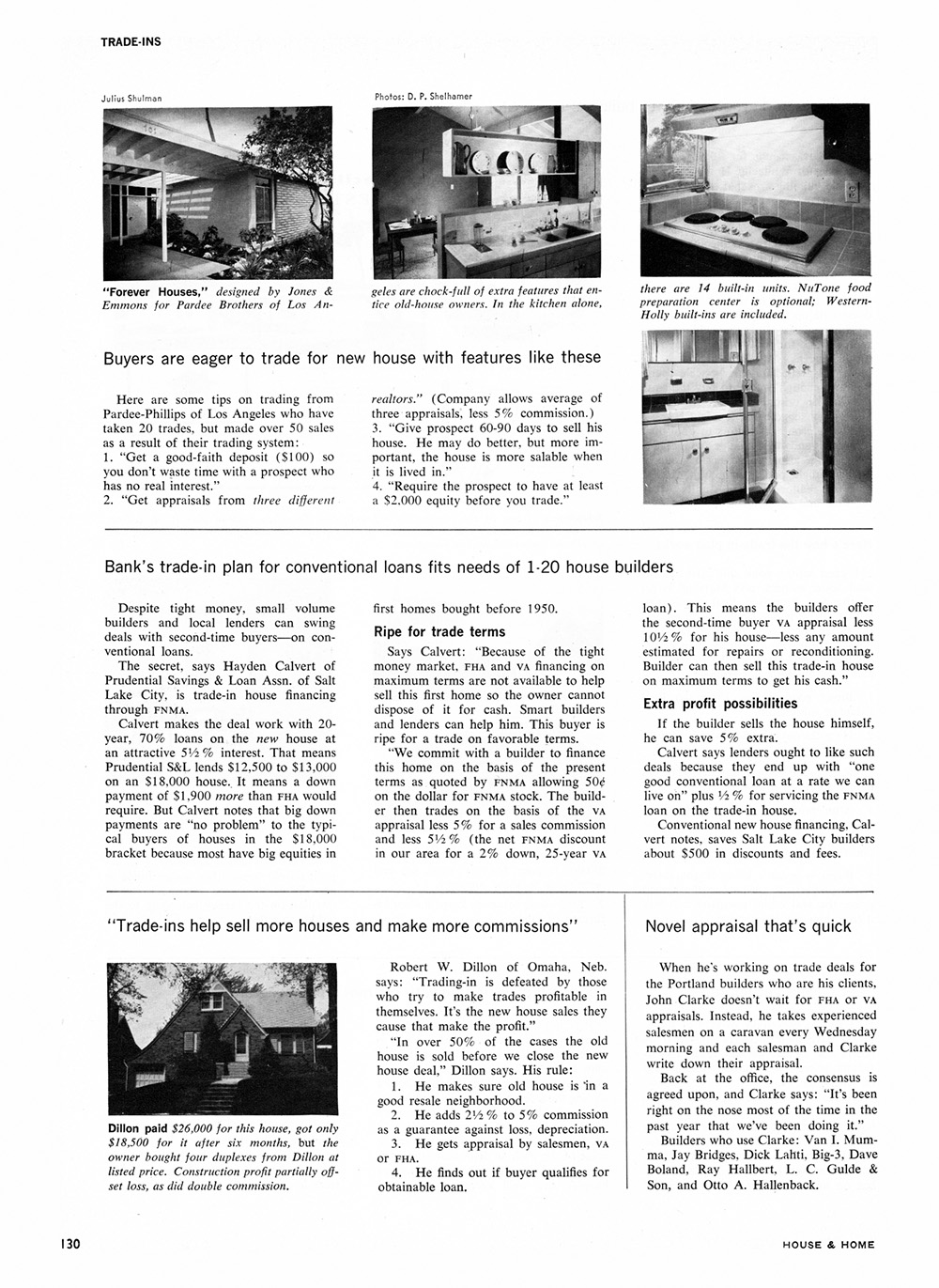


Julius Shulman
"Forever Houses," designed by Jones & Emmons for Pardee Brothers of Los An-
Here are some tips on trading from Pardee-Phillips of Los Angeles who have taken 20 trades, but made over 50 sales as a result of their trading system:
1. "Get a good-faith deposit ($100) so you don't waste time with a prospect who has no real interest."
2. "Get appraisals from three different
Photos: D. P. Shelhamer
geles are chock-full of extra features that entice old-house owners. In the kitchen alone.
realtors." (Company allows average of three appraisals, less 5% commission.)
3. "Give prospect 60-90 days to sell his house. He may do better, but more important, the house is more salable when it is lived in."
4. "Require the prospect to have at least a $2,000 equity before you trade."
there are 14 built-in units. NuTone food preparation center is optional; Western-Holly built-ins are included.
Buyers are eager to trade for new house with features like these
Bank's trade-in plan for conventional loans fits needs of 1-20 house builders
Despite tight money, small volume builders and local lenders can swing deals with second-time buyer-on conventional loans.
The secret, says Hayden Calvert of Prudential Savings & Loan Assn, of Salt Lake City, is trade-in house financing through FNMA.
Calvert makes the deal work with 20-year, 70% loans on the new house at an attractive 5Β½% interest. That means Prudential S&L lends $12,500 to $13,000 on an $18,000 house. It means a down payment of $1,900 more than fha would require. But Calvert notes that big down payments are "no problem" to the typical buyers of houses in the $18,000 bracket because most have big equities in
first homes bought before 1950.
Ripe for trade terms
Says Calvert: "Because of the tight money market, fha and va financing on maximum terms are not available to help sell this first home so the owner cannot dispose of it for cash. Smart builders and lenders can help him. This buyer is ripe for a trade on favorable terms.
"We commit with a builder to finance this home on the basis of the present terms as quoted by fnma allowing 50<β on the dollar for fnma stock. The builder then trades on the basis of the va appraisal less 5% for a sales commission and less 5Β½% (the net fnma discount in our area for a 2% down, 25-year va
loan). This means the builders offer the second-time buyer va appraisal less 1 OΒ½ % for his house less any amount estimated for repairs or reconditioning. Builder can then sell this trade-in house on maximum terms to get his cash."
Extra profit possibilities
If the builder sells the house himself, he can save 5% extra.
Calvert says lenders ought to like such deals because they end up with "one good conventional loan at a rate we can live on" plus Β½ % for servicing the fnma loan on the trade-in house.
Conventional new house financing, Calvert notes, saves Salt Lake City builders about $500 in discounts and fees.
"Trade-ins help sell more houses and make more commissions''
Novel appraisal that's quick
Dillon paid $26,000 for this house, got only $18,500 for it after six months, but the owner bought four duplexes from Dillon at listed price. Construction profit partially offset loss, as did double commission.
Robert W. Dillon of Omaha, Neb. says: "Trading-in is defeated by those who try to make trades profitable in themselves. It's the new house sales they cause that make the profit."
"In over 50% of the cases the old house is sold before we close the new house deal," Dillon says. His rule:
1. He makes sure old house is 'in a good resale neighborhood.
2. He adds 2Β½% to 5% commission as a guarantee against loss, depreciation.
3. He gets appraisal by salesmen, va or FHA.
4. He finds out if buyer qualifies for obtainable loan.
When he's working on trade deals for the Portland builders who are his clients, John Clarke doesn't wait for fha or va appraisals. Instead, he takes experienced salesmen on a caravan every Wednesday morning and each salesman and Clarke write down their appraisal.
Back at the office, the consensus is agreed upon, and Clarke says: "It's been right on the nose most of the time in the past year that we've been doing it." Builders who use Clarke: Van I. Mum-ma, Jay Bridges, Dick Lahti, Big-3, Dave Boland, Ray Hallbert. L. C. Guide & Son, and Otto A. Hallenback.